 |
ANTIQUE BOXES
at the Sign
of the Hygra
2 Middleton Road
London E8 4BL
Tel: 00 44 (0)20 7 254 7074
email: boxes@hygra.com |
Antique Boxes in English
Society
1760
-1900 by
ANTIGONE
WORK - SEWING BOXES |
Sewing Box thumbnail index, a pictorial reference to antique sewing boxes
Request
current list of available sewing boxes.
Request
current list of available sewing boxes.
|
INTRODUCTION
The sewing box or work box was a much loved personal home accessory, where
the lady it belonged to kept her embroidery tools and materials. As ladies
of a certain social standing did not have many outlets for their artistic
creativity, ability to compose and embroider designs on fabric was seen as
a major accomplishment.
There are many references in literature to sewing, embroidery tools and boxes.
In Jane Austen's Mansfield Park the heroine Fanny Price finds solace in "the
room...most dear to her" where " The table between the windows was covered
with work-boxes and netting -boxes…" Jane Austen herself had a large
Chinese export lacquer box/table on stand complete
with fitted tray, which can still be seen in her house in Chawton.
The stylistic development of the work box mirrors that of the
tea caddy. The main difference is that Tea Caddies
are on the whole taller and narrower. The shapes and decoration however follow
the same pattern except that work boxes revert to rectangular shapes after
the middle of the 19th century.
|

Chinese Export Lacquer Sewing Box decorated with scenes of oriental life circa 1850.
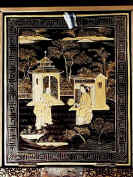

An early 19th Century fully fitted Chinese
export lacquer combined sewing and writing box of rectangular form
opening to a fully fitted sewing tray with turned and carved ivory
tools and having a drawer fitted for writing. Circa 1800

A very fine Chinese export lacquer sewing box of complex curved
octagonal form, with fine decoration of oriental scenes framed within
cartouches standing on gilded bat feet. The background is filled with
diaper designs of stylized flora. Inside there is a lift out tray with
supplementary lids and sewing tools made of turned and carved ivory.
The box has gilded side handles and hinges. Circa 1835.
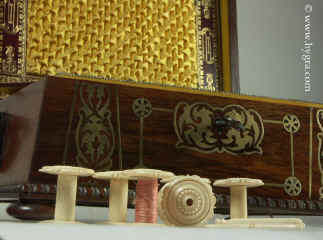
An exceptional and rare fully fitted brass inlaid workbox, which shares
elements with the work by Edwards. The form is typical of the early
Regency: perfectly proportioned drawing its inspiration from ancient
architectural structures. It has turned gadrooning handles and feet
Circa 1815.

Mahogany and brass bound sewing box circa 1820. This is a most unusual
early sewing box, both strong and robust. The high quality of the
structure suggests that it was made to withstand travel as well as sit
in elegant drawing rooms. The mahogany is edged in squared brass all
around and bears flat-folding side handles. The original interior is
lined in red textured leather. The tray is in keeping with the exterior
and is structured for strength. The ‘envelope’ is most unusual and
opens with a silver catch. Some bending on bottom brass suggesting that
the box did travel! Working Bramah lock and key.
%20(Custom).JPG)
Antique box in the sarcophagus form. The box is veneered in figured rosewood and is inlaid in brass depicting stylized flora. The fluid design of stylised flora is exceptionally fine. This is a spectacular box which encapsulates the best of the Regency era. The box stands on turned rosewood feet and has brass lion head drop ring handles. The centre panel of the top is framed with gadrooning as is the pediment adding the architectural impact. The box has a lift out tray which has been relined . Circa 1825.

Antique fully fitted Regency brass inlayed figured rosewood sewing box with original tools 1815
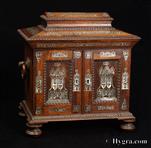
Antique William IV fully fitted rosewood table cabinet of architectural form with secret opening Circa 1835
|
Request
current list of available sewing boxes.
There are basically two categories of boxes dating from this period.
Rectangular boxes with wooden lift out trays over an empty
space. Sometimes instead of a space there is a drawer. The tray, the drawer,
or both are usually divided into compartments. The interior if lined at all,
is lined with simple paper, in pink, blue, green or yellow.
|
Seldom are these boxes made of solid wood. Usually they are made in mahogany,
pine or oak and veneered in saw cut veneers of mahogany, oak, yew, harewood,
partridgewood, satinwood or fruitwoods. The decoration tends to be restrained,
often simple edgings or crossbandings.
More ambitious inlaid decoration of neo-classical or more naturalistic designs
is sometimes found on boxes which have trays fitted with sewing tools. Such
examples are now extremely rare.
Most boxes dating from this period were finished in wax and as such the ones
which have escaped insensitive restoration have built up a rich patina.
Some boxes were varnished. The
varnish has often deteriorated over time |
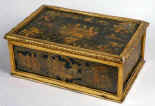
Rare important early 18th Century Venetian box with fielded panels decorated with lacca povera depicting Chinoiserie fantasies, framed with gilt-wood; the inside of the box has a later (early 19th century English) tray, covered in green silk fitted for sewing, circa 1730
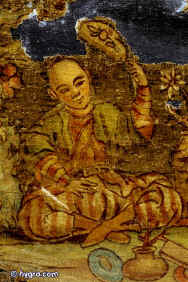
Detail: A young Oriental boy in dress that is more
European than Chinese with the symbols of a scholar prince.

Rare Georgian sewing box
with cherub print and turned Tunbridge ware sewing tools Circa 1800.
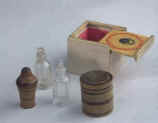

Regency Rosewood and Penwork sewing
Box Circa 1810

Antique Flame Mahogany Sewing Box With Lift-out Tray Circa 1800
|
Request
current list of available sewing boxes.
|
Boxes belonging to this category were painted either on a background of light
coloured wood, usually sycamore, or on a lightly gessoed surface which was
applied to the box before the decoration. These boxes are quite unique and
wonderfully idiosyncratic. Real period gems.
|
%20(Custom).JPG)
Rare Penwork table cabinet with curved Regency shape. The penwork depicts exquisite chinoiserie scenes of figures in the fantastical gardens of Cathay. The compartmentalized interior was fitted for jewelry in the 19th Century. The hinged doors open to four drawers with turned bone handles. The upper part was originally fitted for sewing. The divisions retain their original pink lining paper. The domed top and flared skirted base are unusual. A superb piece of its period. Circa 1820.
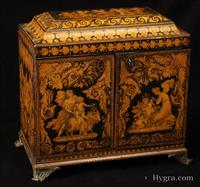
A magnificent Penwork table cabinet bearing the label of R.Ackermann’s, the only labelled example of this iconic repository’s work we have ever seen. It is decorated with classical scenes, romantic views and stylised flora. It opens up to three long and two short drawers, the whole interior decorated in a similar manner. The quality of the painting is of exceptionally high standard both in execution and composition. Although within the traditions of the genre of neoclassicism, this is a work of art which transcends convention by its sheer energy and exuberance redolent of ancient classical art. Circa 1810.
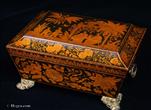
Shaped Regency penwork box decorated with stylised flowers and Chinoiserie scenes, depicting figures in exotic landscapes; some of the figures are European and some Oriental. It stands on period embossed gilded brass feet and also has period embossed brass ring handles. The original tray has been recovered. Circa 1820.
|
|
Subjects vary from flowers to human figures, shells, butterflies, bees or
whatever the particular person was interested in at the time of painting
the box. Many were bought "in the white" and decorated at home by accomplished
and dedicated ladies, eager to prove their gift as competent and inspired
artists.
Most of these boxes were fitted with Tunbridge
Ware early sewing tools. The tools were turned in sycamore and decorated
with simple lines in primary colours. They consisted of small thread barrels,
tubular small boxes, tape measures, wax holders and thimbles.
The barrels were made with a central spindle inside, on which the thread
was wound. The thread was then pulled out from a small hole on the side of
the barrel. The small boxes had screw on lids and were used for holding beads,
gold thread or other precious embroidery necessities. The tape measure holder
was a small tubular box with a central spindle and a slid on the side.
|
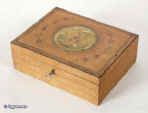
Rare late 18th century inlaid maple fitted sewing box decorated with a hand colored print depicting Autumn Circa 1790.
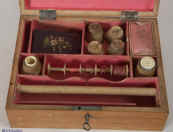
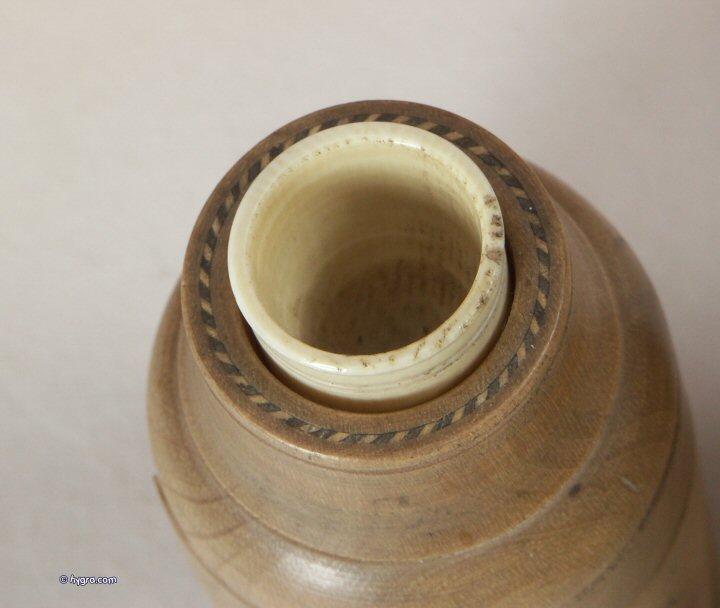
|
This
enabled the silk tape measure to be wound in and out when necessary without
needing to handle it. The waxer consisted of two circles of wood holding
a piece of wax in between them. This was used to wax the as yet unmercerized
thread as it came out of the barrel, rendering it smooth.
|
One section of the lift out tray often contained a removable pin cushion
made up of a light wooden frame, stuffed with bran and covered on the top
with silk. Other sections were left empty or were fitted with removable small
boxes.
Early work boxes sometimes included small glass bottles with glass stoppers.
These were probably used for hand sprinkling powder or aromatic vinegars
and salts. Small 'emery' cushions for keeping rust off needles were also
kept in work boxes.
|

An unusual painted Regency box with curved and tapered sides and pyramided top, having replacement side handles and and opening to two replacement velvet covered lift out trays making the box suitable for jewelry or sewing. The wood is sycamore and the painting depicting floral motifs is finely executed. A wonderful period piece. Circa 1810.
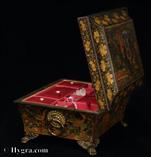
Rare Antique Regency Polychromed fitted sewing box with depictions of Oriental life Circa 1815
%20(Custom).JPG)
Antique Regency shaped fully fitted rosewood sewing box the outside decorated with diamond faceted steel work decoration. The inside is finished in blue paper and silk. The lid is lined with ruched silk framed by a plain border. There is a document wallet behind. The compartmentalized lift out tray has four supplementary lids covered in brocaded silk with decorative pulls. The edges and partitions are accented with cast pewter bead work. The box has original period steel and embossed and chased silver sewing tools. These include scissors with sheath, stiletto, a combined wax-spoon and tweezers, a pin cushion in the form of a wicker basket tape-measure and thimble. Circa 1810.
|
Boxes of this period are now seldom found with more than a few surviving
tools. Even in incomplete condition they are extremely rare.
TORTOISESHELL
Tortoiseshell sewing boxes dating from the end of the 18th century are rectangular.
In the early 19th century sarcophagus, architectural and generally more complex
shapes were readily adopted by the makers of work boxes. See
Tea Caddies.
|
To this was added a new shape
for work boxes that of the basket. This took several forms, tapered, domed
topped, double opening etc. but always with a shaped wooden handle straddling
the box from one side to the other and fixed with turned wooden pegs. There
is such a box in Mrs Fitzherbert's room in the Brighton Pavilion (George
IV's summer palace) although whether the king's mistress ever used it, is
a matter of conjecture.
The exotic woods popular at the time, such as rosewood and kingwood were
used to veneer many fine work boxes, which were then decorated with inlays
in brass, wood and mother of pearl. Sarcophagus style shapes were enhanced
with feet and handles of the type used on Tea
Caddies. |
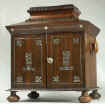
William IV fully fitted
rosewood table cabinet of architectural form Circa 1835.
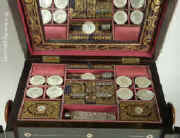
The upper part is a fully
fitted sewing box.
%20(Custom).JPG)
A monumental coromandel ebony compendium table cabinet of architectural form having turned and carved feet and handles. It is profusely inlaid to the top and front with mother of pearl.
The compendium is the personal space for the owner and has a fully fitted sewing tray complete with its original filigree silver and bone thread spools and other tools, There are two drawers for jewelry, and a folding writing box.
|
Penwork Chinoiserie Painted and
boxes combining different types of decoration were made in all shapes. The
interiors of these boxes are very similar to the interiors of the earlier
ones, that is, they have lift out trays or drawers, fitted with turned wooden
tools. Although many of the boxes were still supplied 'in the white,' a greater
number were professionally decorated, especially in Tunbridge Wells. See
Tunbridge Ware
However some of the boxes which were decorated at home dating from this period
are wonderfully eccentric. The interpretations of exotic scenes in penwork
and painting are quite idiosyncratic. Sometimes the boxes were decorated
using an amalgam of techniques, including decoupage, cloth and even feathers!
TUNBRIDGE WARE
Wood decorated Tunbridge Ware work boxes dating
from this period feature cube and vandyke patterns on usually a rosewood
background and are fitted with stickware sewing tools. The sycamore barrels
are either replaced with rosewood barrels or with stickware topped open spools.
The tape measure holder, waxer, winders etc are all in stickware or plain
rosewood.
The range of wood used to decorate these
boxes is unparalleled. It includes: naturally green fungus-attacked oak,
holly, burrs, patterns made in the wood by fungus infection or peculiar
growth, snakewoods (bamboo or palm treated with black polish to create
snakeskin effect) as well as fruitwoods, root woods and exotic timbers newly
arrived in England. The makers laid out the patterns, using the contrasts and
harmonies of the material, with total respect for its natural beauty and
quality. The artistic judgement of the woodworkers in selecting and arranging
these pieces, created some of the strongest and most beautiful boxes ever
made.
|

A early nineteenth century Tunbridge ware shaped Rosewood box with tray, circa 1815

Tunbridge ware box in bird’s eye maple with parquetry in native and
exotic woods, circa 1835.
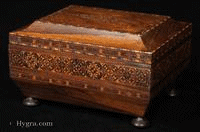
Antique Shaped Tunbrige Ware box with Stickware Parquetry inlay circa 1820

A rosewood veneered Tunbridge ware Sewing box, the
slightly domed top inlayed with a display of roses depicted in micro
mosaic, framed by a wide banding of Berlin wool-work in micro mosaic and
bandings of contrasting light and dark wood; there is a further banding
of Berlin wool work design encircling the box which has concave sides.
The inside retains its original liftout tray which is lined with its
original paper. Inside the lid is lined in red silk. circa 1850
|
|
In addition many other tools were made in painted sycamore or stickware and
were added to the boxes from time to time. It is not unusual to find thimble
cases containing rosewood thimbles, needle cases, clamps, shuttles and small
circular boxes in the tray or the space under it.
Both the boxes and the tools were beautifully made and are excellent examples
of the richness of the woods and the skill and judgement employed by the
Tunbridge Ware makers.
|

Some painted wooden thread barrels.
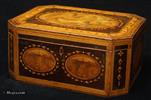
A very rare octagonal Georgian sewing box in harewood with crossbandings in various woods, ovals in burr yew, kingwood and book matched burr wood and inlays of fine leaves and dots. The top is decorated with a hand coloured print of a classical scene and framed in shaded maple, in the form of inlaid rippled ribbon. The whole orchestration of the decoration is rooted in the neoclassical tradition of the late 18th-early19th century and it is one of the finest examples of the genre. The interior contains a wealth of finely turned original sewing tools in the original tray and pieces of its two hundred year old sewing history. This box is an early example of Tunbridge ware, when the work made in the area was more in keeping with the general taste of the country and not particular to the area. There are however pointers to the work specific to the area, such as the subtle use of particularly beautiful small pieces of wood, finely turned wooden tools, the inlay of pointed leaves and dots and the painting of lines on turned pieces. The paper is also typical, although not exclusive to Tunbridge ware boxes. Circa 1800.
|
WOODEN BOXES with OTHER THAN TUNBRIDGE
WARE TOOLS
Other boxes made at this time were veneered in rosewood, kingwood, figured
mahogany and other interesting woods. They were inlaid in wood or brass.
The arrangement of their trays was similar to the above but the tools followed
different patterns. Boxes dating from the first decade mostly had the barrel
type thread containers, but they were made in plain rosewood, ivory or bone.
The other tools were also made of these materials in similar shapes to those
made earlier.
By the second decade the open spool had on the whole superseded the closed
barrel. The first spools consisted of turned and carved circles screwing
onto a bone tube supported by another plain circle on the base. The top circle
was in ivory or mother of pearl. This design did not last for long. It was
soon modified so that the two circles joined each other by the top circle
being attached to a metal tube, which slid over a metal pin attached to the
bottom circle.The other tools, tape measure, waxer etc followed the earlier patterns in
the new materials. Emery cushions were mostly replaced by small tubular
containers with a round opening covered in cloth in which the needle could
be inserted for cleaning.
Thimbles were occasionally in ivory but these were
mostly superseded by silver thimbles, which were placed in prearranged grooved
spaces on the tray. Unlike the French, English boxes did not contain mother
of pearl thimbles. |
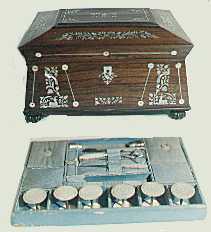
A
Rosewood and Mother of Pearl Sewing Box. Circa 1835.

By the second decade the open spool had on the whole superseded the closed
barrel
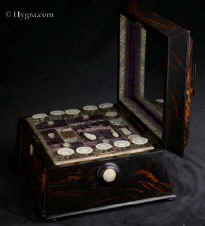
An impressive sewing box veneered in saw cut highly figured coromandel,
fitted with mother of pearl sewing tools. Circa 1835.
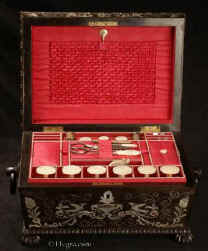
A sewing box of impressive form, decoration and
workmanship, the interior lined with red silk and fully fitted with
mother of pearl sewing tools, Circa 1825.
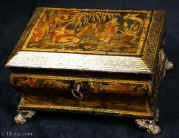
Sewing box with Japanned, raised and
polychromed decoration on this sewing box depicting a truly golden
vision of Cathay. Figures relax in a garden with a distant rock in the
background and the ho-ho bird above. This is a relatively late example
of such work and it does not have an overall varnish. Note how the gold
and the colors have remained brighter than in earlier examples. Circa
1820.
|
The tray itself as well as the inside of the lid became more elaborate. Silk
and gold tooled leather were used to line the lid and to create small pincushions
and covers. The centre of the tray contained a cover over an empty space.
This cover had loops, which held small scissors, stilettos (tools with a
sharp round pointed piece of steel held on a handle), hooks, flat needles,
pencils, folding knives or other tools. These had mother of pearl or ivory
handles.
|
A material used at this time to cover pine work boxes was leather. These
boxes were made in exaggerated Regency sarcophagus shapes, with segmented
tops, concave and convex elements, animal monopodia and drop gilded handles.
The interiors were lined in paper, silk and leather, the lids covered in
pale silk, printed with classical scenes. Most of these boxes have been battered
by age but they still retain an excellent period look.
RECTANGULAR BOXES
In addition to the very handsome shaped boxes, which combine many of
the design elements associated with the Regency period, there are also more
modest boxes dating from the early part of the 19th century.
These are of rectangular shape, mostly in rosewood veneer with simple metal
line and mother of pearl circle decoration.
Other rectangular boxes in other woods with simple crossbandings or edgings
were also made. These boxes still had a tray but they were supplied without
the tools. Although the decoration was restrained they were still made to
a very high standard of craftsmanship and have the subtle appeal of understated
quality.
|
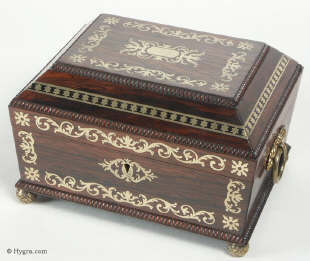
A fully fitted brass inlaid rosewood sewing box with gadrooned edges
gilt side carrying handles and gilt feet. Inside the fully fitted sewing
tray contains a set of turned ivory spools. Circa 1810.
|
|
However rectangular boxes did occasionally have elaborate brass or mother
of pearl decoration and trays fitted with tools. These were presumably made
for people who were not partial to the new shapes, but appreciated the new
decorative styles. These boxes herald the next period when the rectangular
wooden sewing box was back in fashion.
|
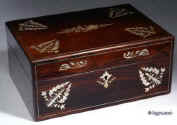
SB123: Antique figured rosewood box with dramatic contrasting mother of pearl inlay depicting native plants, the box opening to a fitted inside with liftout tray with divisions for sewing. The tray is covered in its original 19th C paper and has supplementary lids covered in blue silk. The box has a rounded filet of solid rosewood let into the edges. All the veneers at this period are saw cut and about 1mm thick. Circa 1835.
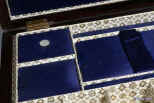
|
PAPIER MÂCHÈ
This is the fine period for papier mâchè
boxes with fine decoration and interesting shapes. When fitted, the trays
often contain mother of pearl spools and tools.
Papier mâchè was the European
craftsmen’s answer to Oriental lacquer. Decorated
lacquer furniture and accessories were becoming increasingly fashionable by
the second half of the 18th century. Natural materials for
producing lacquer were not available in England, but this did not daunt the
native makers. Inspired by the imported wares they set their mind to producing
a material, which would have the same qualities as lacquer.
In the 19th century papier
mâchè boxes were made for a variety of purposes. The nature of the material
which was by now made by the pulped method and pressed into moulds enabled the
makers to create interesting shapes such as bombe, concave and sarcophagus,
often standing on plinths or round feet.
|
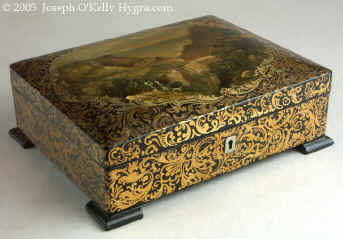
An artist painted Papier mâchè sewing box having its original fully
fitted tray with Dieppe turned and carved spools and sewing tools Circa
1820.
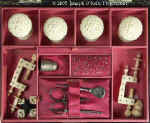
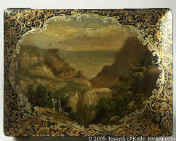
The painting depicts a
mountainous landscape. In the background the sea with sailing dinghies
meets the cloudy sky. In the foreground are two fowlers one having just
discharged his gun. Their dog is still at their side. The bird would
not be ease for the dog to retrieve.

A painted Fully fitted Papier
mâchè Sewing box Circa 1835.


The
finely painted landscape scenes are painted on a gold ground which gives
a iridescence.
|
ANGLO INDIAN
This is the period of very fine Anglo Indian work
boxes, in Sadeli mosaic, ivory, horn and quills. The sandalwood trays were
occasionally fitted with ivory tools in the earlier barrel designs. The Sadeli
boxes contained Sadeli topped barrels and container lids. This is by far
the best period for Sadeli mosaic and work boxes dating from this time are very
rare.
All Anglo Indian Regency boxes are now rare. Boxes, which are completely
covered in Sadeli mosaic in good condition, are very rare indeed.
Indian craftsmen showed incredible
aptitude in adapting to the whims of the times. Boxes even in the shape of
baskets were produced in the Regency period, although these still had the
typical incised borders. This was not the case with the "English
Cottage" shaped sewing boxes, which had incised decoration in
naturalistic style with doors, tiles and climbing flowers. They were
certainly made to gratify the expatriate nostalgia for the English
countryside.
The mosaic technique is a very
interesting example of the aptitude of the Tunbridge Ware workers to
assimilate and adapt techniques and designs from other cultures. Stone
mosaics were uncovered in the much talked about excavations of the 18th
century. Mosaic covered boxes were known in England by the beginning of
the 19th century by which time exquisite Sadeli
Mosaic had already been introduced from India.
The ancient art of Sadeli Mosaic is said
to have been introduced from Shiraz in Persia via Sind to Bombay, a long
time before the Anglo Indian boxes were made. It was a technique, which
required a high degree of skill and patience. It was executed very
lavishly, in that the frequent cuts wasted a great amount of the precious
materials used. The workmanship was however more than commensurable to the
value of the materials.
|


Very Fine Early 19th C. Anglo
Indian Ivory and Sadeli Mosaic Sewing Box. Circa 1820.
The ivory thread barrel is inlaid with Sadeli mosaic.

An Anglo Indian Vizagapatam radiating faded black
buffalo horn of dramatic curved shape Circa 1835

Anglo-Indian (Vizagapatam) box in wood covered in horn, of sarcophagus form, with a segmented radiating top culminating in a turned and carved floral finial. An Indian interpretation of English Regency aesthetic. This is a small box which shows absolute mastery of design. Circa 1840.
|
CHINESE EXPORT LACQUER
This is the best period for work boxes in this material. Each box represents
countless hours of skilled work. Sometimes they are rectangular but mostly
they are in rounded sarcophagus shapes with very fine gold decoration depicting
oriental scenes. Most have lift out trays containing turned and carved ivory
tools, barrel thread containers, circular boxes, thimbles, waxers, tape measures,
sometimes clamps and other tools. These are larger than most other work boxes
of the period. Most have a drawer on the lower part opening to reveal small
writing surface. |

Chinese Export
Lacquer Sewing Box with Ivory tools Circa 1820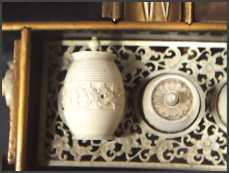
Sewing barrels turned and carved. The thread would come out of the small
hole.
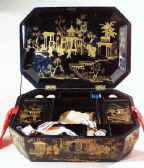
Antique Chinese Export Lacquer
Sewing box, circa 1840.
|
TORTOISESHELL
Compared to tea caddies very few work boxes were made. On the whole they
followed the caddy styles except that the interiors had trays sometimes fitted
with ivory or mother of pearl tools.
STRAW WORK
Fine small Napoleonic prisoner of war boxes for holding thread were made
at this time.
|
By the middle of the century shapes reverted back to the rectangular. Earlier
whimsical decoration went out of fashion. Mother of pearl and brass inlays were
still favourite, although the earlier repetitive brass scrolls gave way to free
standing motifs. Mother of pearl, abalone shell and brass were used together to
form flowers, birds and butterflies.
|
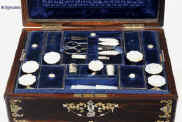
SB120: A fully fitted sewing box veneered in thick striated coromandel and inlaid in brass and shell, both mother of pearl and abalone. Inside there is the original fitted liftout tray lined with silk and velvet, with a set (6) of carved and turned mother of pearl daisy pattern spools designed for the new thread which now came on wooden reels. The tray also has supplementary lids with carved mother of pearl pulls. The box also has period sewing tools including penknife button hook, and tweezers, and bodkin with mother of pearl handles. The steel scissors is designed for cutting button holes. There is a document wallet in the lid. Circa 1870.
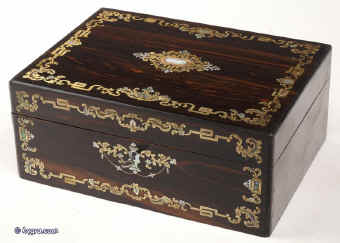
|
Mother of pearl inlays without brass became cruder, sometimes no more than
diamond designs. Wood marquetry was now in naturalistic designs, mainly of
flowers. This was often very skilfully done, still using the natural woods
contrasts, although sometimes enhanced with stains.
|
Coromandel and walnut were used more frequently than rosewood for veneering
the main body of the box. Walnut veneers were cut very thin and highly polished.
Indeed by now all the boxes were finished in glossy French polish.
Very few trays were fitted with tools. The ones which were, contained mother
of pearl topped spools and steel tools with mother of pearl handles. Trays
became increasingly simpler, covered in silver paper with silk topped covers.
The inside of the lid was covered with padded silk, opening into an envelope
type compartment. Very few boxes had gold tooled leather.
By the last quarter of the century walnut veneered boxes with geometric inlay
bands were made in great numbers. Pretty and useful, they edged out the more
ambitious Tunbridge Ware. The trays by now were very standard and were not
supplied fitted with any tools. |
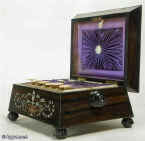
Victorian fully fitted coromandel sewing box of architectural shape inlaid with mother of pearl abalone and metal, with turned handles and feet. circa 1845
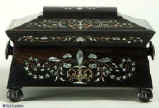

Antique opulent fully fitted sewing box in ebony
profusely inlaid with tortoiseshell, engraved brass, mother of
pearl and abalone. The inside has a silk covered lift out tray
retaining a set of sewing tools including turned and carved mother
of pearl spools with matching tape measure and needle cleaner. A central
tray has steel tools with tortoiseshell handles. Circa 1840.
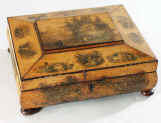
Antique
Scottish Sewing box, with transfer decoration circa 1840.
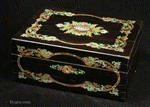
Antique Fully fitted ebony Sewing box with mother of pearl, abalone, brass and Parkesine inlay Circa 1860
|
TUNBRIDGE WARE
Tunbridge ware work boxes of the period are decorated with the characteristic
mid 19th century Berlin woolwork mosaic motifs. The trays are covered in
darker often patterned paper and if they contain any tools these are mostly
in stickware.
PAPIER MÂCHÈ
Good papier mâchè boxes with mother of pearl and painted decoration
continued to be made well into the Victorian era. There was not much change
from earlier boxes, except perhaps a tendency for larger sizes. Tools if
any, were in mother of pearl. As the century progressed to its last quarter
the boxes followed the decline of the whole industry.
ANGLO INDIAN
The only good examples of Anglo Indian work boxes from this period are early
examples of carved work in sandalwood. These contain Indian silver tools
and occasionally glass perfume bottles. Such examples are very rare
indeed.
Most other boxes dating from this period are in a combination of carved wood
and strips of later period Sadeli mosaic. The trays are fitted with Sadeli
topped barrels. Pretty though they are, these boxes were made in greater
numbers for the English export market and lack the finesse of the early Anglo
Indian work.
CHINESE EXPORT LACQUER
These are similar to earlier examples. However as by now the Chinese market
was open to all and was no longer the monopoly of the East India Company,
examples of lesser quality were made to fullfil the growing demand. However
these still required many days of very skilled work and are quite beautiful.
A few good examples with very fine decoration also date from this period.
By the last decades of the century, they had gone out of fashion together
with all things oriental.
|
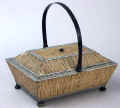
Anglo Indian, Vizagapatam Porcupine Quill Horn and Ivory Basket-form box Circa 1850.
.thumb.JPG)
A sandalwood basket veneered in horn and ivory. Although such baskets were a popular Vizagapatam design, this one is very unusual in that it combines both solid ivory panels incised and lac filled in traditional plant motifs and fretted ivory work. Furthermore, the central cartouches are engraved with representations of Indian deities and not floral designs which was the normal decoration on such baskets. It stands on lion paw feet. The handle is decorated with scrolling flowers in characteristic fashion. Circa 1870.

Box veneered in walnut and
inlaid in strips of geometric marquetry of light and stained woods circa
1880.

Box veneered in walnut and
inlaid in strips of geometric marquetry of light and stained woods circa
1880.
|
Request
current list of available sewing boxes.
Thumbnail index of boxes
|
Buying
boxes| Contact
us | The
Schiffer Book | Advanced
Search
© 1999-2015 Antigone Clarke and Joseph O'Kelly
|
